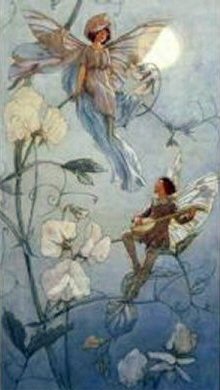|
|
|
HOW DO FAIRIES LOOK AND WHAT DO THEY WEAR

Descriptions of how fairies look and dress are varied in folklore and literature.
Some descriptions are:
From "Encyclopaedia Britannica" -- Fairies are usually conceived as being characteristically beautiful or handsome and as having lives corresponding to those of human beings, though longer. They have no souls and at death simply perish. They often carry off children, leaving changeling substitutes, and they also carry off adults to fairyland, which resembles pre-Christian abodes of the dead. People transported to fairyland cannot return if they eat or drink there. Fairy and human lovers may marry, though only with restrictions whose violation ends the marriage and, often, the life of the human. Some female fairies are deadly to human lovers. Fairies are said to be of human size or smaller, down to a height of 3 inches (7.5 cm) or less. Female fairies may tell fortunes, particularly prophesying at births and foretelling deaths. Several herbs, especially St.-John's-wort and yarrow, are potent against fairies, and hawthorn trees, foxglove, and groundsel are so dear to them that abuse of these plants may bring retribution.
**********
Thomas Crofton Croker (1798 - 1854) has described fairies as being "a few inches high, airy and almost transparent in body; so delicate in their form that a dewdrop, when they chance to dance on it, trembles, indeed, but never breaks."
General Description:
They wear a red conical cap; a mantle of green cloth, inlaid with wild flowers; green pantaloons, buttoned with bobs of silk; and silver shoon. They carry quivers of adder-slough, and bows made of the ribs of a man buried where “three lairds’ lands meet;” their arrows are made of bog-reed, tipped with white flints, and dipped in the dew of hemlock; they ride on steeds whose hoofs would not “dash the dew from the cup of a harebell.” (Cromek.)
“Fairies small, two foot tall,
With caps red on their head.”
--Dodsley’s Old Plays: Fuimus Troës, i. 5
**********
Wales: fairies are said to resemble beautiful fair humans with golden hair. They usually wear green, but the courtiers of the Welsh Fairy King Gwyn ap Knudd are described as being dressed in red and blue silk. Smaller fairies are more beautiful and virtuous and taller fairies are more dishonest. One group is tiny--the other group is as tall as a man's knee.
**********
Ireland:
---The Banshee is described as wearing a gray cloak over a green dress. She has glowing red eyes in hollow sockets and long flowing white hair.
---Leprechauns are described as having a little wizened, gray-bearded face with twinkling eyes and a pointed nose. He wears a red jacket with silver buttons, brown breeches, black silver-buckled shoes and a high crowned hat.
**********
Scotland: fairies are capable of appearing in practically any shape or size, but they are usually have quite small human shapes. They female are very beautiful but at the same time show intense, sometime vicious, ill will or hatred. The Fairy Queen is described by Thomas the Rhymer as wearing green and riding a horse with silver bells plaited into its mane.
**********
France: fairies are said to change shape, ranging in their look from being beautiful humans to hideous shapes of complete invisibility. They are called fées. They are said to be predominantly female.
**********
Spain: fairies are called Fada (from the Latin fatum, which means fate, which they could control by enchantment). They have a malicious ability for deception and vindictive spite even for their own kind.
**********
Lithuania: fairies, Deives and Laume, are beautiful, blond, blue-eyed female fairies transformed from former deities
**********
Hungary: fairies are mainly female and take a shape and size similar to humans but are more magical in appearance.
**********
Albania: fairies are said to be magnificently beautiful
**********
Persia or Iran: fairies are described as being light, tiny gossamer creations and are called Peri.
**********
Native American - traditions include beings such as the gentle, beautiful Cloud People and Shiwanna, who shape shift into rainbow colors or remain invisible to work their magical powers.
**********
--Dictionary of Phrase and Fable, 1898
-- Spirits, Fairies, Leprechauns and Goblins, an Encyclopedia, 1996
--The Columbia Encyclopedia: Sixth Edition. 2000